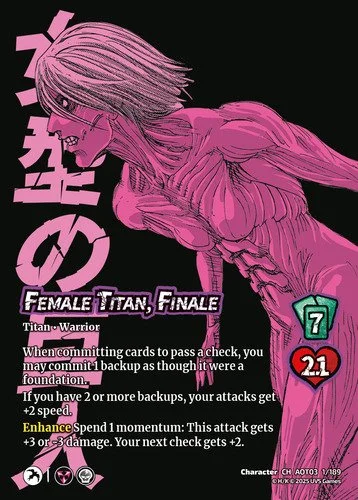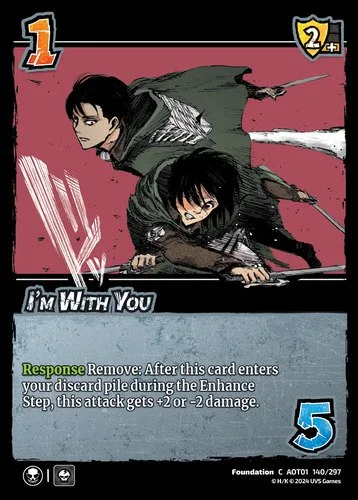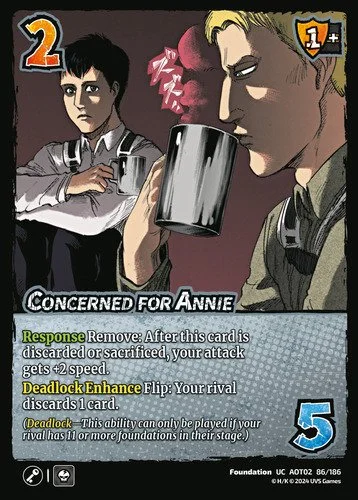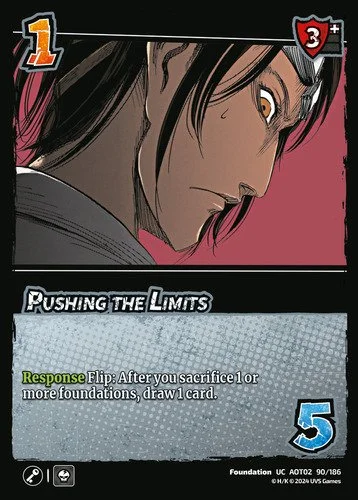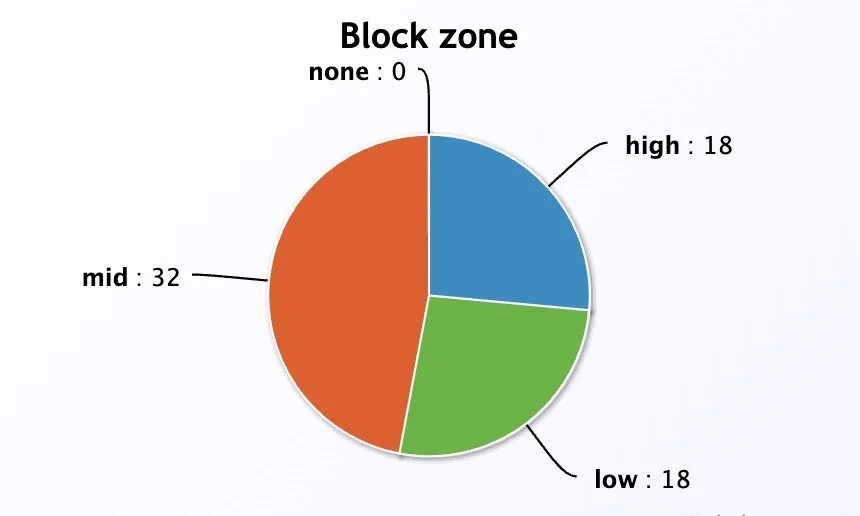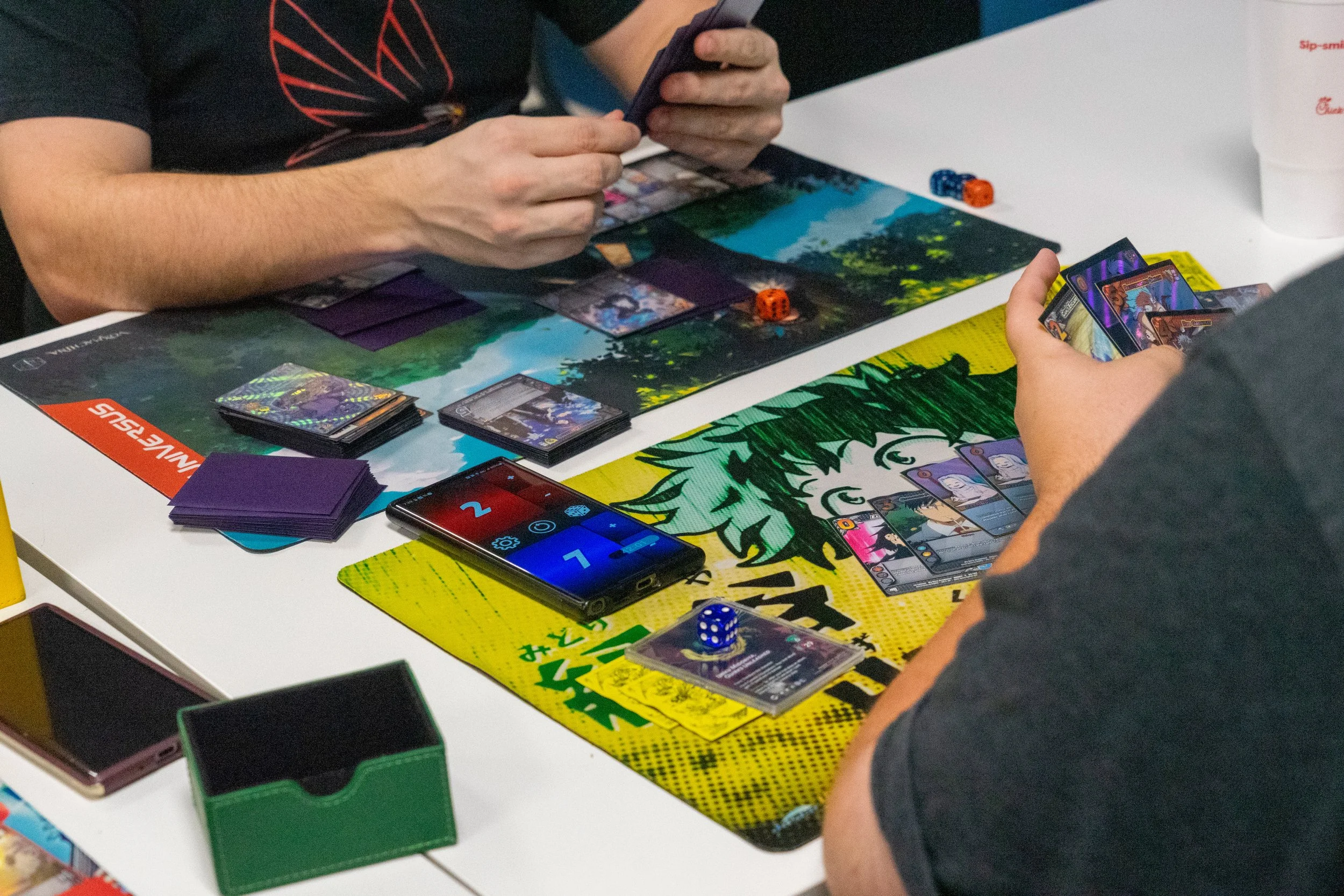Ms. Leonhart, Or: How I Learned to Stop Whining and Embrace the Meta (Part 2)
by Dani Diaz
Part 2: The Deckbuild (and How to Build in Paper)
I built Annie in paper with the help of teammate Richard at our last event. In this article, I’ll go over the thought process of selecting cards from my collection, our technique for building in paper, and my basic gameplan for piloting Annie Leonhart, Awakened.
The first thing I did was assess Annie’s abilities. She has a static ability that reads “When committing cards to pass a check, you may commit 1 backup as though it were a foundation.”
This means I can run a higher ratio of backups because they can double as cards I can use to pass checks. Her next ability reads “Enhance [Your Attack] Sacrifice 1 backup or foundation: Add the top card of your deck to your momentum. If you have 3 or more momentum, transform Annie Leonhart, Awakened.”
Initially, I thought this meant for me to lean into the Death symbol cards with ability triggers on being destroyed or entering the discard pile. So, I built her with cards like I’m With You, Concerned for Annie, and Pushing the Limits.
Initial testing led me to drop that gameplan after I realized I could only capitalize on those triggers when Annie was on her front side. Once I transformed and began my offense, those foundations were essentially blank, and I couldn’t benefit from their effects the way other Death symbol foundation destruction characters could. I needed to find another way.
Chaos received a ton of momentum-generating tools in the last few sets, and Attack on Titan: Apocalypse added even more character support that seemed tailor-made for Annie. This seemed like the right symbol to play her on since we could use lots of momentum cheating abilities that propelled our attack turns to ludicrous extents. I grabbed a pile of cards from my collection and brought them to CounterSpell.
Deck Construction Theory
When we construct decks, we tend to think in four main card types:
· Gameplan
· Game Flow
· Defense
· Win Conditions
Gameplan cards help feed your character’s abilities and get you closer to your win condition. For Annie, that’s momentum gain and cards that help get backups onto the field.
Game Flow cards help you manage your tempo in the game, whether managing your hand or board state. Drawing, hand filter, and tutors all go into this category. Check manipulation and board control also help control the game flow.
Defense is one of the most important categories for a seven-hand size, aggro character. If your offense sputters, you must be able to live until you can swing again. Cards that reset speed and damage, damage reduction, and damage negation cards go in here.
Finally, Win Conditions are the cards (typically attacks) that seal the game for you. I have a basic wincon in mind for Annie: string out until my opponent is down. I also have a secondary wincon we’ll talk about in just a moment.
My primary Gameplan cards are Duplicitous Recollection, Support from the Female Titan, Theo Magath, and The Nine Titans from throughout the Ages.
Duplicitous helps build in either Theo or the War Hammer Titan from my discard pile if one ended up there during one of my build turns. Support helps me cheat momentum and draw cards, and it happens whether the attack deals damage or not! Theo Magath helps pump my outgoing damage and reduce incoming damage, so he’s in contention for best card in the deck. The Nine Titans does the same, doubling the damage or speed on my powerful Titan attacks and reducing damage at response speed. It being non-unique is a very strong aspect if I manage to get multiple on the field as well.
The Game Flow cards I chose are A Master’s Pride, Inspiring Song, Jaw Titan’s Bite, Shaun Gilmore, Devastating Loss and Rapid Speed Slash.
Master’s Pride flips and re-readies when I cheat momentum with Rapid Speed Slash or Support from the Female Titan, helping me maintain my tempo. Inspiring Song and Shaun Gilmore offer check manipulation on both offense and defense, and Jaw Titan’s Bite allows me to tutor that attack from my discard pile to assist with win turns. Devastating Loss allows me some asset and backup hate, especially for things like Cape of No Return and Military Airship.
The Defense package in this deck includes Sole Motivation, Broken Psyche, Dark Ward, Protecting Yukina, Moment of Normalcy, and Filled with Doubt.
Sole Motivation and Broken Psyche are the primary speed and damage reduction cards, and my ability to cheat momentum ensures Psyche is almost always online. Dark Ward allows me to cancel response abilities in the card pool, such as the pesky Breaker keyword ability that will slow down my attack turns. If the enemy plays an attack I don’t want to deal with, I have Filled with Doubt to seal it at response speed on play and prevent any powerful abilities from being played. Protecting Yukina acts as throw hate, which is especially important in a 21-health character, and Moment of Normalcy is a commit-cost reset that ups my survivability considerably.
Finally, the Win Conditions are Surprising Transformations and Harness Undeath.
Surprising Transformations may be, well, a surprising pick, but its blitz-speed stat gain and ability to echo are sometimes too much for the rival to overcome. Two attacks becoming four is enough to shred most defensive hands. Harness Undeath is much in the same vein but has an incredible burn effect we can trigger by losing 2 health when it connects. This card in combination with Inspiring Song to mill backups into my discard leads to some big damage burns only a few turns into the game. It’s probably my favorite card in the game since I love playing backup decks so much!
The Lines
A solid Annie win turn starts with at least three momentum on deck and a Theo Magath and any other backup on board. If I have any combination of Support from the Female Titan, Jaw Titan’s Bite, or Surprising Transformation there is a good chance I can get there, depending on defensive pieces in the rival’s stage. If you managed to build a War Hammer Titan, use the First Form to build in two additional foundations for check fodder!
I typically lead off with a Support from the Female Titan to get that extra momentum and possibly an extra attack from the card draw. It is important to spend the momentum judiciously, but if your opponent only has a card or two in hand, don’t be shy about pumping your damage from the first attack.
Your triggers are typically momentum based. If you checked a 3 on your Support, add the momentum and flip/re-ready your Master’s Prides. Spend your momentum on your +3 damage, respond with Theo for 2 more, and add +2 to your next check. Make sure you’re only using this bonus to play attacks - it’s incredibly situational to spend it on an action like Surprising Strength and feels straight up bad if your opponent has an ability to force a check out of you.
The best followups are Jaw Titan’s Bite, which can fish itself out of discard, and Surprising Transformation which can echo itself for a very attainable cost with Annie. Utilize these cards to shred your opponent’s hand and when you’re sure you can connect, land the Harness Undeath.
Sacrifice a backup to give the attack Echo and add to the eventual burn. Pump the damage with Annie and Theo, and let the fireworks begin!
There are other situationally good lines beginning with Duplicitous Recollection and War Hammer Titan Attacks! and we will for sure discuss those during testing. Once you try this deck out, comment your favorite lines below!
Building in Paper
Now that we have our main cards picked out, let’s talk about how we built the deck.
Start by stacking up all your cards according to card type (all attacks together, all foundations together, etc.). Then starting with your attacks, separate your cards into three piles: high blocks, mid blocks, and low blocks. Fan them out slightly so you can count them. Continue this process with your other card types until you have fanned out all the cards on the table. We usually have dice on hand so we can maintain a tally of each, but you can use a pen and paper if you like.
Now, we balance the deck’s contents by using a general ruleset that we swear by at CwC:
· 4-of cards that you need to win the game
· 3-of cards that help your gameplan, but aren’t necessary to win
· 2-of cards that are nice to have but aren’t necessary to win
· 1-of cards that are situationally good or matchup dependent
Once you have a rough idea of your ratios, you can look at your difficulty curve! Your curve is what will determine if you have success during your first and possibly second turn builds. Generally, you want more 1- and 0-difficulty foundations than 2-difficulty and up, and you want more lower-difficulty attack than higher-difficulty ones. These rules vary by situation and character, so test it out and see how your curve feels!
After your curve is looking good, look at the block zones. You don’t want an overload in any one block zone, but sometimes it’s inevitable based on the pool of cards available to you. If you do get overloaded and you know you have cards with better block zones in your collection, feel free to move cut copies of other blocks over just so you have a visual representation of your blocks.
In my Annie deck, I have 18 high blocks, 32 mid blocks, and 18 low blocks. This seems like a lot, but with my ability to reduce and negate damage, half blocking is at least viable if I’m forced to. Plus, the general strategy of the deck is to flip and win and fast as possible, so the block zones aren’t quite as important. Your mileage can and will vary based on your deck and playstyle!
The deck should be in a good spot now, so sleeve it up and get ready to play some test games! These will help you figure out what cards and ideas are working and what are not. In the next article, we’ll go over my initial test games with Annie and how I adjusted the deck from there.
Thanks for reading, and as always, keep coping!



